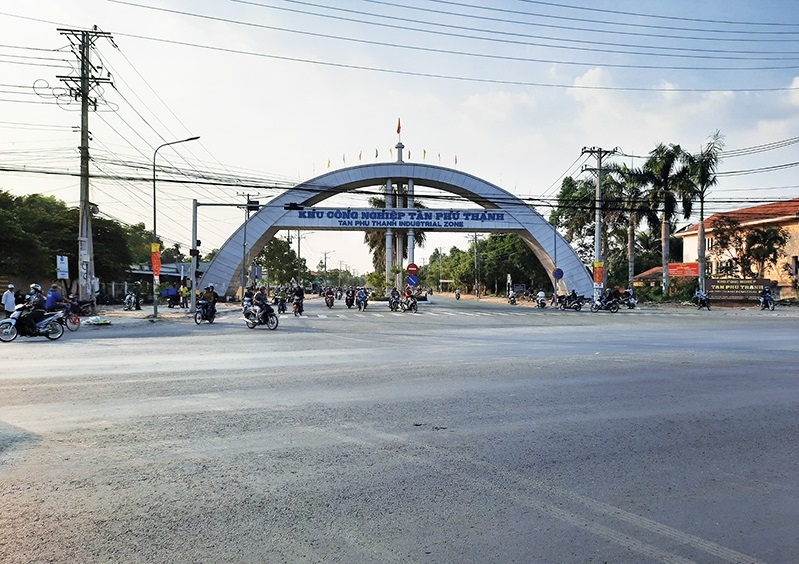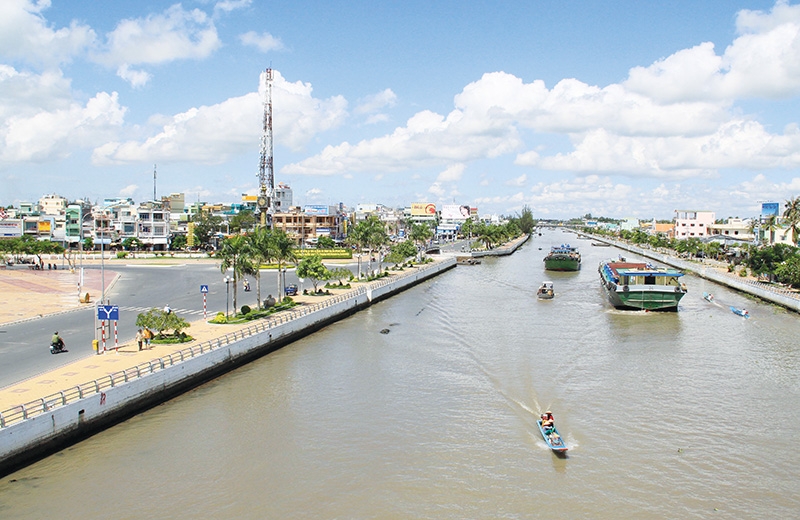Hau Giang’s breakthrough successes bucking the trend
 |
| Dong Van Thanh, Chairman of Hau Giang People’s Committee |
The first year of implementing the socioeconomic development plan for the 2021-2025 period was marked with numerous hardships due to the heavy impacts of the pandemic. What has been achieved thus far this year?
With the lucid direction of the government, the prime minister, and the provincial Party Committee as well as the efforts, creativity, and determination of the whole political system, Hau Giang has overcome multiple hardships to effectively implement the targets of effectively containing the pandemic and ensuring socioeconomic development.
Of the 18 major socioeconomic targets set in 2021, two targets have achieved the yearly plan already – the number of enterprises declaring tax and communes achieving new rural status. Nine targets have achieved more than 70 per cent of the full-year plan and one target has surpassed 50 per cent.
According to the General Statistics Office, the regional GDP growth rate for the Hau Giang reached 5.99 per cent, of which the trade and services sector expanded 6.8 per cent on-year.
Among the targets exceeding the province’s plan, the total budget revenue is considered a bright spot with revenues touching VND6.676 trillion ($290.2 million) in the first six months, showing 18.38 per cent jump over the same period last year, and reaching almost 90 per cent of the figure assigned by the provincial Party Committee and the provincial People’s Council in 2021.
Investment attraction in the province also posted positive results with 38 domestic projects worth VND5 trillion ($217.3 million) in total registered capital, an excess of 27 projects and VND4 trillion ($139 million) of more than one year ago. This year marked a sharp increase in the number of projects landing in the province.
With a high budget revenue in 2020 well as in the first six months this year, Hau Giang is taking the lead in the Mekong Delta in terms of the state budget. What factors have made such impressive results?
In addition to the efforts of the whole political system and the people, this is the great contribution of enterprises currently doing production and business in the province. Hau Giang has always determined that attracting investment is one of the key solutions, providing the fulcrum for the province’s sustainable development. The province, therefore, has been focusing on perfecting socioeconomic infrastructure, improving the business investment environment, and creating optimal conditions for investors.
As a result, the province has lured in many big projects. Minh Phu Seafood Corporation has opened a shrimp export factory; Aquaone Water JSC opened a water refinery with a capacity of 800,000-1,000,000 cubic metres per day; Masan Group opened the White Lion brewery; and Can Tho-Hau Giang Cement Co., Ltd opened a cement factory.
Besides all that, Tan Hiep Phat Group established the Number One Hau Giang beverage factory project, and Vingroup has opened a Vincom trade centre in Vi Thanh city. In addition, many sizable real estate groups made their presence felt in the province with a string of projects on urban area development, or building trade and service centres in the province.
 |
| Government, enterprises, and individuals are working together to improve the province’s infrastructure |
By attracting many large-scale projects, it proves that investors see many advantages when developing production and business in Hau Giang. What are the main factors that have helped the province charm investors?
In addition to the typical advantages of the Mekong Delta as the largest agricultural and seafood material area of the country, Hau Giang has a distinct advantage of acting as a hub for traffic, waterway transport, and trade-services and logistics connections of the south Song Hau area. These create favourable conditions for the transportation of goods as well as effectively serving the travel needs of individuals and businesses.
In the near future, the An Giang - Can Tho - Soc Trang and Can Tho - Ca Mau expressways will be passing through the province, enabling Hau Giang to connect with other localities in the region. In particular, over the next few years, Hau Giang will use targeted capital sources allotted from the central budget to invest in fresh projects in transport infrastructure, as well as industrial zones (IZs) and agricultural infrastructure development.
Regarding waterway transport, the Hau River flows through the province, which is the main route to diverse local ports such as Cai Cui, Hoang Dieu, Hau Giang, and My Thoi. The Xa No and Quan Lo-Phung Hiep canals are national waterways connecting the delta to Cambodia and other Southeast Asian countries. With its location adjacent to Can Tho city, Hau Giang fully benefits from a full suite of infrastructure facilities of this vibrant development centre of the Mekong Delta. Hau Giang is also attractive to investors by virtue of numerous preferential policies the province offers to investors. Home to seven out of eight district-level administrative units determined as having extremely difficult conditions for development, businesses would then receive top incentives in terms of corporate income tax, import tax, land rent, water surface rent, and more when landing projects in the province.
 |
What solutions does the province apply to best make use of its potential to spur growth socially and economically?
The resolution of 14th Party Congress of Hau Giang province for the 2020-2025 term set out the goals of concentrating resources on economic development, pushing up investment attraction, promoting the synergy of assorted economic sectors, and creating conditions for business development. Of equal importance is mobilising diverse investment resources for socioeconomic development, giving priority to industry and sustainable development of agriculture; stimulating investment into trade, services, and tourism; and striving to post a fair average growth pace. Notably, priority solutions in the forthcoming period are set as identifying industrial development as a breakthrough, developing smart agriculture as a foundation, and developing green services as support to underpin the sustainable development of industry and agriculture.
What are the breakthrough tasks Hau Giang will implement to bolster the province’s investment attraction?
To spur on socioeconomic development and investment attraction particularly, Hau Giang has identified three breakthrough tasks.
First is completing and strictly implementing the province’s development planning for 2021-2030, with a vision to 2050. Priority would be given to mobilising investment resources to complete the construction of infrastructure in IZs and industrial clusters (ICs) to create clean land funds, and developing important waterway transport infrastructure connecting different areas in the province and between Hau Giang and other localities in the region.
Heading towards 2025, efforts will be made to complete the procedures to five more IZs and five more ICs, along with expanding two more clusters.
As for transport infrastructure development, Hau Giang strives to complete and put into use projects with investment proposals, such as building provincial road 931 and the section from Vinh Vien town to Xeo Vet Bridge; provincial road 926B connecting the Quan Lo-Phung Hiep route with Soc Trang province, and Road No.927 connecting Phuong Binh commune to Cay Duong town.
At the same time, plans are underway to build 10 key roads with a total cost surpassing $465 million from assorted capital sources, as well as calling for public-private partnership investment into building roads passing through urban areas with a total investment of more than $130 million.
The second factor is building and perfecting local institutions and policies, especially the system of mechanisms and policies to attract investment, as well as develop enterprises and co-operatives through low-cost policy and incentive provision.
Lastly is implementing strong administrative reforms, paired with building an e-government and pushing up the digital transformation of industries and fields; beefing up IT application across the board; striving to improve the provincial competitiveness index ranking; and building a lean government apparatus from grassroots to provincial level, ensuring transparent and effective operation with the motto of accompanying and effectively serving both individuals and businesses.
What the stars mean:
★ Poor ★ ★ Promising ★★★ Good ★★★★ Very good ★★★★★ Exceptional
 Tag:
Tag:
Related Contents
Latest News
More News
- Global partnerships key to Vietnam’s IFC development (December 26, 2025 | 16:18)
- Vingroup pulls out of bid to invest in North-South high-speed railway (December 26, 2025 | 11:42)
- Strengthening supply chains through trade promotions and customs reform (December 24, 2025 | 14:00)
- PM orders investment model for North–South high-speed rail (December 22, 2025 | 17:43)
- LS Eco Energy to invest in Vietnam rare earth sector (December 22, 2025 | 17:31)
- Government moves to establish International Financial Centre (December 21, 2025 | 21:00)
- Vietnam's IFC to target global investment flows (December 21, 2025 | 18:00)
- Two national hospitals expand capacity with new facilities (December 20, 2025 | 09:00)
- Ha Tinh breaks ground on major Vingroup industrial and energy projects (December 19, 2025 | 18:24)
- EVN launches major power infrastructure projects nationwide (December 19, 2025 | 18:17)























 Mobile Version
Mobile Version